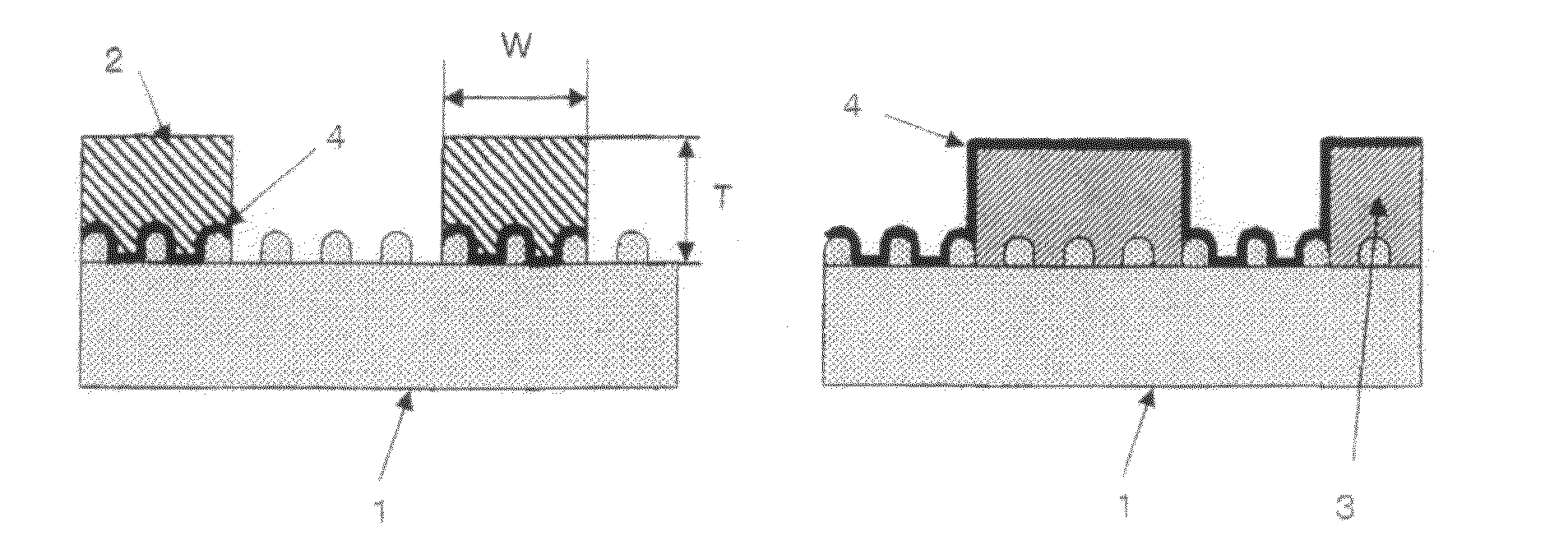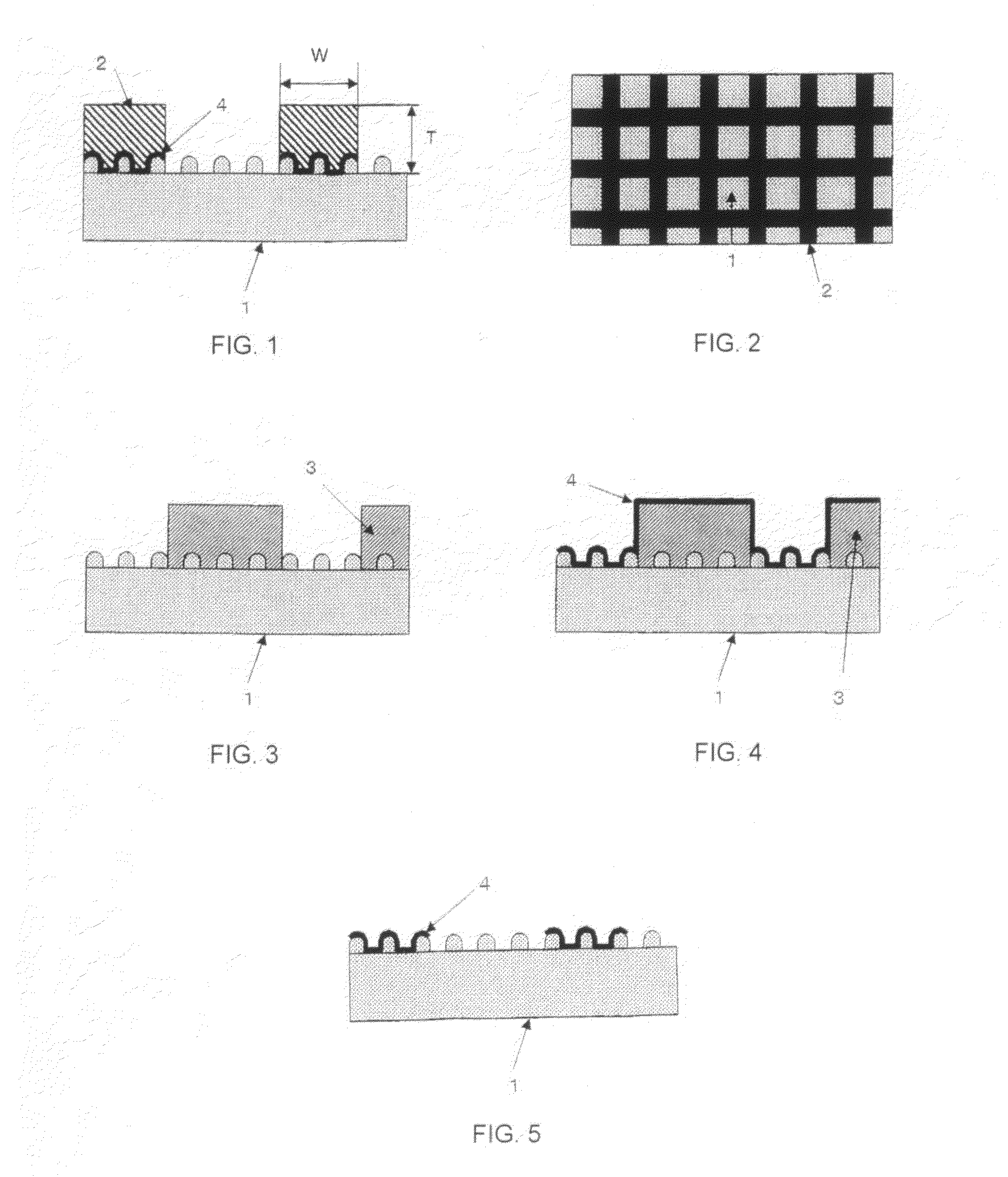Transparent electrically conductive film and process for producing the same
a technology of electrical conductivity and transparent film, which is applied in the direction of photosensitive materials, conductive layers on insulating supports, instruments, etc., can solve the problems of increasing production costs, affecting the quality of electrical conductivity, and unable to afford satisfactory electromagnetic wave shielding properties, etc., to achieve excellent electrical conductivity, reduce the number of manufacturing steps, and produce in high yield and inexpensively.
- Summary
- Abstract
- Description
- Claims
- Application Information
AI Technical Summary
Benefits of technology
Problems solved by technology
Method used
Image
Examples
examples
[0035]The present invention will be described below in more detail by way of examples, but the invention is not limited to the following examples. Transparent, electrically conducive films produced by the following working and comparative examples were evaluated in the following manner.
(1) Concaves / Convexes of Film and Height T of Metal Layer
[0036]A part of film was cut out and a thin piece thereof was cut out in a sectional direction with a microtome, then was observed and measured using a laser microscope (LEXT OLS3000, a product of Olympus Co., Ltd.).
(2) Width W of Metal Layer
[0037]The width of a metal layer of a transparent, electrically conductive film was measured from a surface of the same layer with use of a laser microscope (LEXT OLS3000, a product of Olympus Co., Ltd.).
(3) Electrical Conductivity
[0038]Measured using LORESTA AP (4-pin probe method) (a product of Mitsubishi Chemical Co., Ltd.).
(4) Transmittance
[0039]The transmittance of light (visible light) having a wavelen...
example 2
[0041]A layer containing alumina (refractive index 1.56) with an average particle diameter of 0.1 m was laminated to a surface of a PET film (light transmittance 92%, refractive index 1.55) to afford a transparent film having concaves and convexes with an average height of 0.05 μm. Then, a photosensitive resist (PER20 SC03, a product of Taiyo Ink Mfg. Co., Ltd.) was applied onto the film surface to a thickness of 10 μm, followed by exposure and development, to afford a film having 300×300 μm resist blocks arranged at 20 μm intervals. Next, the film was subject to electroless copper plating in the same way as in Example 1 to afford a transparent, electrically conductive film. This film was then subjected to electrolytic copper plating to afford a transparent, electrically conductive film according to the present invention having a metal layer width W of 20 μm, a metal layer thickness of 5 μm and a W / T ratio of 4. An EVA adhesive was applied to the surface of the transparent, electric...
example 3
[0042]A layer containing silica (refractive index 1.46) with an average particle diameter of 0.1 μm was laminated to a surface of a PET film (light transmittance 92%, refractive index 1.55) to afford a transparent film having concaves and convexes with an average height of 0.05 μm. Then, a photosensitive resist (PER20m SC03, a product of Taiyo Ink Mfg. Co., Ltd.) was applied onto the film surface to a thickness of 10 μm, followed by exposure and development, to afford a film having 100×100 μm resist blocks arranged at 50 μm intervals. Next, the film was subjected to electroless copper plating in the same way as in Example 1 to afford a transparent, electrically conductive film according to the present invention having a metal layer width W of 50 μm, a metal layer thickness T of 0.1 μm and a W / T ratio of 500. A EVA adhesive was applied to the surface of the transparent, electrically conductive film and a PET film having a reflection preventing layer was laminated thereto.
PUM
| Property | Measurement | Unit |
|---|---|---|
| height | aaaaa | aaaaa |
| refractive index | aaaaa | aaaaa |
| thickness | aaaaa | aaaaa |
Abstract
Description
Claims
Application Information
 Login to View More
Login to View More - R&D
- Intellectual Property
- Life Sciences
- Materials
- Tech Scout
- Unparalleled Data Quality
- Higher Quality Content
- 60% Fewer Hallucinations
Browse by: Latest US Patents, China's latest patents, Technical Efficacy Thesaurus, Application Domain, Technology Topic, Popular Technical Reports.
© 2025 PatSnap. All rights reserved.Legal|Privacy policy|Modern Slavery Act Transparency Statement|Sitemap|About US| Contact US: help@patsnap.com


